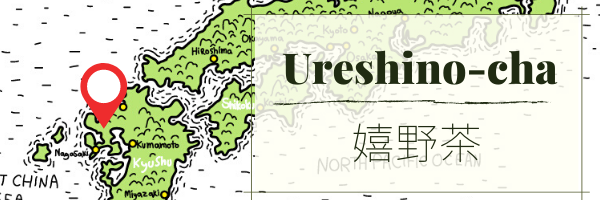Ureshino-cha (Saga / Nagasaki)
Introduction
Ureshino-cha is the name of the tea produced in the tea fields spanning from Ureshino City in Saga prefecture to Higashisonogi Town in the Nagasaki prefecture of Japan.
The volume of production of the Ureshino-cha is not large. As a matter of fact, it only accounts for 2% of the entire Japanese Green Tea Market.
Nonetheless, Ureshino-cha has a name for itself, and is extremely famous despite this lack of production. This is mainly because of the quality of the unique tea which it produces.
The Ureshino-cha brand is extremely premium when it comes to Kamairi-cha and the Mushisei-Tamaryokucha. Both types of tea produced in this area are regular winners of the "Production Area award" and the " "Minister of Agriculture, Forestry and Fisheries award" in the Annual National Tea Competition of Japan. Ureshino-cha indeed represents Japan for these types of teas.
Characteristics
Most of the tea farms for Ureshino-cha is centered in and around Ureshino City. It is an area characterised by moderate hills and thick fog. The area is blessed with a warm climate and fairly long daylight hours as well. Mix in the drop of temperature during the night, and you'll find that there are many beneficial factors suitable for producing high quality tea in this area.
95% of the production of Ureshino-cha is actually Mushisei-Tamaryokucha. Only about 5% is the Kamairi-cha, and is more and more being treated as an endangered art. There are even movements in the area trying to preserve the Kamairi-cha before it goes extinct.
In 2002 the definition of the "Ureshino-cha" brand was clearly defined. Only the tea using 100% leaves cultivated in the Saga and Nagasaki prefectures are and can be called "Ureshino-cha". If the percentage of leaves coming from Saga and Nagasaki prefecture is between 100% and 50% of the tea, then it is called the "Ureshino-blend".
The Kamairi-cha
The Kamairi-cha is a rare type of Japanese tea which is manufactured by roasting, rather than steaming, to stop the oxidation of the tea leaves. This manufacturing method and the taste is actually similar to Chinese tea, and therefore it is said to be a hybrid of Japanese tea and Chinese tea. You can read in detail about the Kamairi-cha here.
It has a signature appearance - the tea leaves of the Kamairi-cha are shaped like a "comma". This is the shape it becomes as it is roasted and gradually stirred in a huge pan.
As the production process is extremely labor intensive, the production has dropped more and more. Currently the Kamairi-cha is extremely rare, and you may be lucky to come across any.
The Mushisei-Tamaryokucha (Guri-cha)
The look is similar to Kamairi-cha in that it is shaped like a "comma", but the manufacturing method of this tea is actually it's very different. Instead of roasting the leaves, they are unoxidized by steaming, just like it is done for a normal Sencha.
As this very light and refreshing tea accounts for 95% of the tea production in Ureshino, it can be said that this is the main type of Ureshino-cha.
[reference]
https://www.city.ureshino.lg.jp/kanko/tokusanhin.html
https://jasga.or.jp/agriculture/nousanbutsu/ureshino_cha

